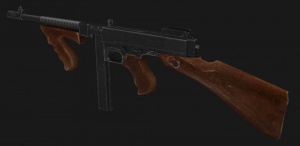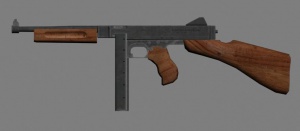Thompson Model 1928
Thompson Model 1928

| |
| Model 1928 Thompson | |
| Specifications | |
| Type | Submachine Gun |
| Caliber | .45 cal |
| Feed System | 30 Round Magazine |
| Rate of Fire | 720 Rounds/Min |
| Muzzle Velocity | 280m/s |
| Maximum Effective Range | 110m |
History
Auto-Ordnance Corp. (AO) was founded in 1916 with the goal of producing a new automatic weapon. Co-founder John Tagliaferro Thompson, formerly a brigadier-general in the U.S. Army Ordnance Department, led a team that two years later produced a hand-held weapon of a class for which he coined the term “sub-machine gun”.
The Thompson Model 1921 and its characteristic dual pistol grips went on the market March 1921. It relied on friction acting on a metal wedge to lock bolt and receiver together long enough to allow the breech pressure to drop. When the pressure dropped, the wedge slipped and unlocked the breech. The gun fired the standard US service .45cal (11.43mm) automatic pistol cartridge.
The Model 1921 took advantage of the finest traditions in American guncraft and cost too much for widespread military use, but the Irish Republican Army and American gangsters liked it so much it became known as the “Gangster Gun”, the "Chicago Typewriter" and "Chicago Piano", due to the popular association between that city and gangsters. It was also used by police departments and several American industries with union problems. Even the U.S. Post Office bought 250 Thompsons, to equip Marines detailed to guard mail shipments.
In 1928, the U.S. Navy, impressed with the combat performanceof the "Tommy Gun" in Marine hands in Central America and China, expressed an interest in purchasing a Thompson with a reduced rate of fire. AO complied and produced the U.S. Navy Model of 1928 with a stock in place of the front pistol grip, sling swivels, and a Cutts compensator that reduced muzzle climb. The Navy ordered 500. The U.S. Army gave the gun a go in 1932, adopted it in 1936, and named it the “Submachine gun, Caliber .45 M1928A1” in 1938. All guns after the Navy order are commonly called Model 1928s.
Prior to 1939, the British armed forces had shunned submachine guns as weapons of criminals. Following the German invasion of France - and France’s order of 3,000 Model 1928s in November 1939 - Britain bought 450 Thompsons plus ammunition in January 1940. These orders used up AO’s inventory of Model 1921 parts, with the consequence that many Model 1928s had a mishmash of features, most noticeably either a front grip or stock. The French ordered another 3,000 in March 1940 and the British Army eventually requested 107,500 Thompsons by the end of that year.
Although moderately heavy for an infantry weapon, the Thompson is well balanced and easily aimed. The weight helps absorb recoil and allows the operator to maintain a steady stream of fire. The weapon was favored for its compactness, its hard-hitting .45-caliber rounds, and its high volume of automatic fire. Like all submachine guns, the Thompson lacks lethality at long range, but it could consistently concentrate fire beyond 100 yd. Reliable, the gun would almost never jam and could withstand harsh conditions.
Subsequent M1 and M1A1 models improved on the basic Tommy gun. By the time production ceased in 1945, a total of 1,750,000 complete guns, plus enough component parts to make another 250,000, had been produced.
Game Play
- This weapon is issued to the British submachine gunner. It is the bulkiest of the submachine guns and is more useful when used in urban or close quarter combat. It is very effective at killing crewman of anti-tank and anti-air guns.
M1A1 Thompson

| |
| M1A1 Thompson | |
| Specifications | |
| Type | Submachine Gun |
| Caliber | .45 cal |
| Feed System | 30 Round Magazine |
| Rate of Fire | 720 Rounds/Min |
| Muzzle Velocity | 280m/s |
| Maximum Effective Range | 110m |
History
The M1A1, standardized in October 1942 as the United States Submachine Gun, Cal. .45, M1A1, could be produced in half the time of the M1928A1, and at a much lower cost. The main difference between the M1 and M1A1 was the bolt. The M1 bolt had a floating firing pin and hammer, the bolt of the M1A1 had the firing pin machined to the face of the bolt, eliminating unnecessary parts. The reinforced stock and protective sight wings were standard. The 30-round magazine became more common. In 1939, Thompsons cost the government $209 apiece. By the spring of 1942, cost-reduction design changes had brought this down to $70. In February 1944, the M1A1 reached a low price of $45 each, including accessories and spare parts, although the difference in price between the M1 and M1A1 was only $0.06. By the end of the war, the M1A1 was replaced with the even lower-cost M3.
Game Play
- This weapon is issued to the American submachine gun. It is the bulkiest of the submachine guns and is more useful when used in urban or close quarter combat. It is very effective at killing crewman of anti-tank and anti-air guns.